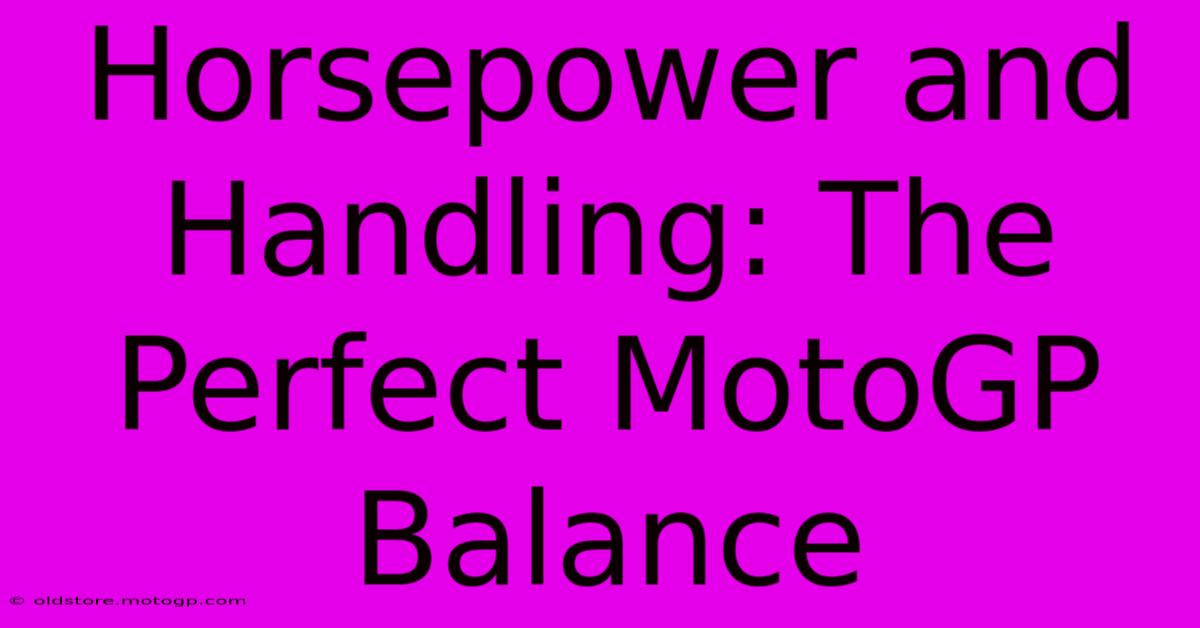Horsepower And Handling: The Perfect MotoGP Balance

Table of Contents
Horsepower and Handling: The Perfect MotoGP Balance
MotoGP. The pinnacle of motorcycle racing. The roar of the engines, the breathtaking speeds, the nail-biting overtakes – it’s a spectacle that captivates millions. But behind the drama and excitement lies a delicate dance between two crucial elements: horsepower and handling. Finding the perfect balance between raw power and nimble control is the key to MotoGP success. This article delves into the intricacies of this crucial relationship and explores how teams strive for the ultimate synergy.
The Power Play: Horsepower in MotoGP
MotoGP bikes are beasts. These prototypes boast upwards of 260 horsepower, capable of reaching speeds exceeding 200 mph. This immense power is the foundation of speed, allowing riders to blast down straights and gain crucial advantages. The relentless pursuit of increased horsepower is a constant in MotoGP development. Engineers constantly refine engine designs, exploring new materials and technologies to squeeze every last drop of power from their machines.
Key Factors Affecting Horsepower:
- Engine Design: The type of engine (currently 1000cc four-stroke inline engines), its internal components, and the intricacies of the combustion process are all critical in determining horsepower output.
- Aerodynamics: While primarily impacting handling, aerodynamics also affect horsepower by reducing drag and allowing for higher top speeds. The sleek fairings and sophisticated wings are crucial elements.
- Fuel and Lubricants: High-performance fuels and lubricants are essential for maximizing power output and ensuring engine reliability during the intense demands of a race.
The Art of Control: Handling in MotoGP
While horsepower provides the speed, handling dictates how effectively that speed can be utilized. A powerful bike that's difficult to control is a recipe for disaster. Exceptional handling allows riders to navigate corners with precision, maintain stability under braking, and execute rapid direction changes. This involves a complex interplay of various factors:
Key Factors Affecting Handling:
- Chassis Geometry: The design of the frame, swingarm, and suspension significantly influences how the bike responds to rider input and interacts with the track surface. This involves meticulous adjustments to rake, trail, and wheelbase.
- Tyre Technology: MotoGP tyres are highly specialized, offering exceptional grip and responsiveness. The choice of tyre compound and the meticulous management of tyre pressures are crucial for optimal handling.
- Electronics: Sophisticated electronics systems, including traction control, wheelie control, and engine braking, play a critical role in managing power delivery and enhancing stability, especially during corner entry and exit.
- Aerodynamics: The aerodynamic design of the bike, including winglets and fairings, significantly influences high-speed stability and cornering performance.
The Delicate Balance: Finding the Perfect Synergy
The challenge for MotoGP teams lies in achieving the perfect balance between these two seemingly opposing forces. Too much horsepower without adequate handling can result in instability and crashes. Conversely, exceptional handling with insufficient power means a lack of competitiveness on the straights.
The quest for this optimal balance is a continuous process of experimentation, data analysis, and refinement. Teams constantly tweak settings, making minute adjustments to chassis geometry, engine mapping, and aerodynamic configurations to find the sweet spot. Rider feedback is also crucial, as the rider's skill and preferences play a significant role in determining the optimal setup.
Data analysis using sophisticated telemetry systems plays a vital role in understanding the bike's performance characteristics and identifying areas for improvement. This data helps engineers fine-tune the setup to optimize both horsepower and handling for specific track conditions.
The Future of Horsepower and Handling in MotoGP
The relentless pursuit of performance continues in MotoGP. Future developments are likely to focus on further refining engine technology, improving aerodynamics, and enhancing electronic control systems. This evolution will inevitably lead to even more powerful and agile motorcycles, pushing the limits of both horsepower and handling even further. The quest for the perfect balance will remain a central theme in this ever-evolving world of motorcycle racing.

Thank you for visiting our website wich cover about Horsepower And Handling: The Perfect MotoGP Balance. We hope the information provided has been useful to you. Feel free to contact us if you have any questions or need further assistance. See you next time and dont miss to bookmark.
Featured Posts
-
F1 Qualifying Experience The Speed Today
Feb 19, 2025
-
Moto Gps Greatest Rivalries Watch On Tnt Sports
Feb 19, 2025
-
F1 Vs Moto Gp The Heart Of Racing
Feb 19, 2025
-
The F1 Starting Grid A Deep Dive Into Strategy
Feb 19, 2025
-
Moto Gp Photoshoot A Moment In Time
Feb 19, 2025
